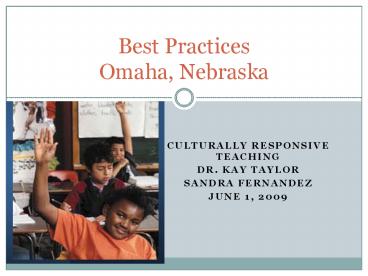CULTURALLY RESPONSIVE TEACHING - PowerPoint PPT Presentation
1 / 16
Title:
CULTURALLY RESPONSIVE TEACHING
Description:
... of all cultural groups, i.e., do NOT use deficit thinking or model ... Sandra L. Fernandez. Coordinator of National Origin. Midwest Equity Center ... – PowerPoint PPT presentation
Number of Views:606
Avg rating:3.0/5.0
Title: CULTURALLY RESPONSIVE TEACHING
1
Best Practices Omaha, Nebraska
- CULTURALLY RESPONSIVE TEACHING
- DR. KAY TAYLOR
- SANDRA FERNANDEZ
- JUNE 1, 2009
2
Introduction
- Who we are . . .
3
Introduction
- Participants
- Affiliation/position/grade taught
- Average number of students in class(es)
- Brief demographics
- Why selected this seminar and what do you hope to
learn.
4
Activity
- Groups
- Respond
- What do you think Culturally Responsive Teaching
means?
5
Walk About
- Look for similarities and differences
- Write on another poster sheet to share
- Put list on wall when done
- Prompt What does responsive mean? Understanding
and acting on, in educationally constructive
ways, (Gay, p. 52, 2000)
6
Different Terms
- Cultural Competence Comes from social work
literature. Example Kansas State Universitys
Multicultural Competencies - http//www.k-state.edu/tilford/MulticulturalCompet
encies.htm - Cultural Proficiency (Lindsey, Robins, Terrell,
2003) - Inside out approach, i.e., you must first know
yourself - - who you are to then undertake the process to
teach - students in a culturally responsive way
- http//video.google.com/videoplay?docid-601752990
473453204eikx0USoRZjPyuAobnkGMqGenevaGayhle
n
7
Culturally Responsive Teaching
- Culturally Responsive Teaching is part of a
multicultural teaching repertoire - Validating and Affirming
- Comprehensive
- Multidimensional
- Empowering
- Transformative
- Emancipatory
- (Gay 2000)
- http//www.intime.uni.edu/multiculture/curriculum/
culture/Teaching.htm
8
Validating and Affirming
- Using cultural knowledge and prior experiences to
make learning relevant. It teaches to and
through student strengths. It validates and
affirms the students culture. - Session facilitators share
- I dont see color. All students are the same.
9
How can we affirm and validate our students?
- Variety of teaching strategies
- that connect to different learning
- styles
- Teach students to praise their
- own and others cultural heritage
- Infuse culture in all school subjects
10
Self-Reflection
- Importance of self-reflection is to become
better educators . . . - We need to develop reflective practice . . .
- We need to be critically conscious and
reflective of our beliefs, knowledge, and
values. - This allows us to explore, question, and
speculate about ourselves.
11
Comprehensive
- Using cultural references to teach skills
- Appropriate for lesson
- All parts of me are nurtured in the learning
environment. - Skills are taught within the curriculum
- Within the curriculum not separate
- Respect the culture of students
- High educational expectations for ALL students
- Belief that students are part of a supportive
environment - Build an academic community of learners in which
human dignity is honored and students individual
self-concepts are then promoted
12
Multidimensional
- Includes (My culture is apart of every subject
area) - Curriculum content
- Climate of the class
- Relationship (teacher/student)
- Performance assessments
- (offer students choice in the form
- of evaluation and assessment)
- Feedback
- Written
- Peer
- Observation
13
Empowering
- Builds personal confidence
- Teachers demonstrate high expectations for
student Success - Students believe they can Learn the tasks AND
take Ownership of their own learning - Curiosity
- Mastery
- Teaching styles
- Differentiated learning
14
Transformative
- Respecting cultures and experiences of ALL
students - Teachers are encouraged to change
social/classroom environment - Using appropriate teaching resources materialsGo
Beyond the Textbook!!! - Teaching
- Emphasize the cultural strengths and
accomplishments of all cultural groups, i.e., do
NOT use deficit thinking or model
15
Emancipatory
- Liberating (Asante, 1991 Au 1993 Erickson,
1987 Gordon, 1993) - Students of color are released from the
constraints of mainstream knowledge Help
students realize that no single version of
truth is total and permanent (p. 35)
Incorporate multiple perspectives - Authentic learning about different cultural
groups - Promotes pride that is both psychological and
intellectual creates the freedom for students
to be who they are rather than covering up
their cultural identity - Increased learning
- High achievement
16
Questions/Comments
Thank You
- Dr. Kay Ann Taylor
- Associate Professor
- Foundations of Education
- Department of Secondary Education
- Kansas State University
- ktaylor_at_ksu.edu
- Sandra L. Fernandez
- Coordinator of National Origin
- Midwest Equity Center
- Kansas State University
- sfdz_at_ksu.edu

